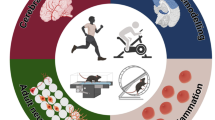Abstract
The purpose of this study was to ascertain whether vitamin C supplementation during chronic exercise training alters rat brain antioxidant content. Female Wistar albino rats were exercised on a treadmill for 30 min/day for 6.5 weeks and were administered daily intraperitoneal injections of vitamin C (20 mg/kg). After the training period, chronically exercised rats showed no significant changes in total brain thiobarbituric acid reactive substances (TBARS) levels. In contrast, rats supplemented with vitamin C during the training period showed significantly elevated brain TBARS levels. If such results were extrapolated to man, where vitamin supplementation is a common practice, this would indicate that vitamin C supplementation may not protect brain tissue against exercise-induced oxidative damage, in such circumstances, this water-soluble antioxidant behaves as a pro-oxidant. (Mol Cell Biochem xxx: 135–138, 2005)
Similar content being viewed by others

References
Guyton AC, Hall, EH: Textbook of Medical Physiology,16th edn. WB Saunders Company, Philadelphia, 1996
Davies KJ, Quintanilha AT, Brooks GA, Packer L: Free radicals and tissue damage produced by exercise. Biochem Biophys Res Commun 107: 1198–1205, 1982
Duthie GG, Robertson JD, Maughan RJ, Morrice PC: Blood antioxidant status and erythrocyte lipid peroxidation following distance running. Arch Biochem Biophys 282: 78–83, 1990
Evans WJ: Vitamin E, vitamin C, and exercise. Am J Clin Nutr 72: 647S–652S, 2000
Raps SP, Lai JC, Hertz L, Cooper AL: Glutathione is present in high concentrations in cultured astrocytes but not in cultured neurons. Brain Res 493: 398–401, 1989
Rose RC: Cerebral metabolism of oxidized ascorbate. Brain Res 628: 49–55, 1993
Ji LL: Antioxidants and oxidative stress in exercise. Proc Soc Exp Biol Med 222: 283–292, 1999
Agus DB, Gambhir SS, Pardridge WM, Spielholz C, Baselga J, Vera JC, Golde WV: Vitamin C crosses the blood-brain barrier in the oxidized form through the glucose transporters. J Clin Invest 100: 2842–2848, 1997
Jacob RA, Burri BJ: Oxidative damage and defense. Am J Clin Nutr 63: 985S–990S, 1996
Clarkson PM, Thompson HS: Antioxidants: what role do they play in physical activity and health? Am J Clin Nutr 72: 637S–646S, 2000
Somani SM, Ravi R, Rybak LP: Effect of exercise training on antioxidant system in brain regions of rat. Pharmacol Biochem Behav 50: 635–639, 1995
Somani SM, Husain K, Diaz-Phillips L, Lanzotti DJ, Kareti KR, Trammell GL: Interaction of exercise and ethanol on antioxidant enzymes in brain regions of the rat. Alcohol 13: 603–610, 1996
Husain K, Somani SM: Effect of exercise training and chronic ethanol ingestion on cholinesterase activity and lipid peroxidation in blood and brain regions of rat. Prog Neuropsychopharmacol Biol Psychiatry 22: 411–423, 1998
Repka T, Hebbel RP: Hydroxyl radical formation by sickle erythrocyte membranes: role of pathologic iron deposits and cytoplasmic reducing agents. Blood 78: 2753–2758, 1991
Paolini M, Pozzetti L, Pedulli GF, Marchesi E, Cantelli-Forti G: The nature of prooxidant activity of vitamin C. Life Sci 64: PL273–278, 1999
Kurtel H, Granger DN, Tso P, Grisham MB: Vulnerability of intestinal interstitial fluid to oxidant stress. Am J Physiol 263: G573–G578, 1992
Elmann GL: Tissue sulyphydryl groups. Arch Biochem Biophys 82: 70–77, 1959
Berger J, Shepard D, Morrow F, Taylor A: Relationship between dietary intake and tissue levels of reduced and total vitamin C in the nonscorbutic guinea pig. J Nutr 119: 734–740, 1989
Liu L, Yeo HC, Overvik-Douki E, Hagen T, Doniger SJ, Chyu WD, Brooks GA, Ames BN, Chu DW: Chronically and acutely exercised rats: biomarkers of oxidative stress and endogenous antioxidants. J Appl Physiol 89: 21–28, 2000
Somani SM, Husain K: Interaction of exercise training and chronic ethanol ingestion on antioxidant system of rat brain regions. J Appl Toxicol 17: 329–336, 1997
Ozkaya YG, Agar A, Yargicoglu P, Hacioglu G, Bilmen-Sarikcioglu S, Ozen L, Aliciguzel Y: The effect of exercise on brain antioxidant status of diabetic rats. Diabetes Metab 28: 377–384, 2002
Radak Z, Kaneko T, Tahara S, Nakamoto H, Pucsok J, Sasvari M, Nyakas C, Goto S: Regular exercise improves cognitive function and decreases oxidative damage in rat xbrain, Neurochem Int 38: 17–23, 2001
Hara M, Iigo M, Ohtani-Kaneko R, Nakamura N, Suzuki T, Reiter RJ, Hirata K: Administration of melatonin and related indoles prevents exercise-induced cellular oxidative changes in rats. Biol Signals 6: 90–100, 1997
Radak Z, Taylor AW, Ohno H, Goto S: Adaptation to exercise-induced oxidative stress: from muscle to brain. Exerc Immunol Rev 7: 90–107, 2001
Brahma B, Forman RE, Stewart EE, Nicholson C, Rice ME, Ascorbate inhibits edema in brain slices. J Neurochem 74: 1263–1270, 2000
Ashton T, Young LS, Peters JR, Jones E, Jackson SK, Davies B, Rowland CC: Electron spin resonance spectroscopy, exercise and oxidative stress: an ascorbic acid intervention study. J Appl Physiol 87: 2032–2036, 1999
Author information
Authors and Affiliations
Corresponding author
Rights and permissions
About this article
Cite this article
Coşkun, Ş., Gönül, B., Güzel, N.A. et al. The effects of vitamin C supplementation on oxidative stress and antioxidant content in the brains of chronically exercised rats. Mol Cell Biochem 280, 135–138 (2005). https://doi.org/10.1007/s11010-005-8421-y
Received:
Accepted:
Issue Date:
DOI: https://doi.org/10.1007/s11010-005-8421-y



